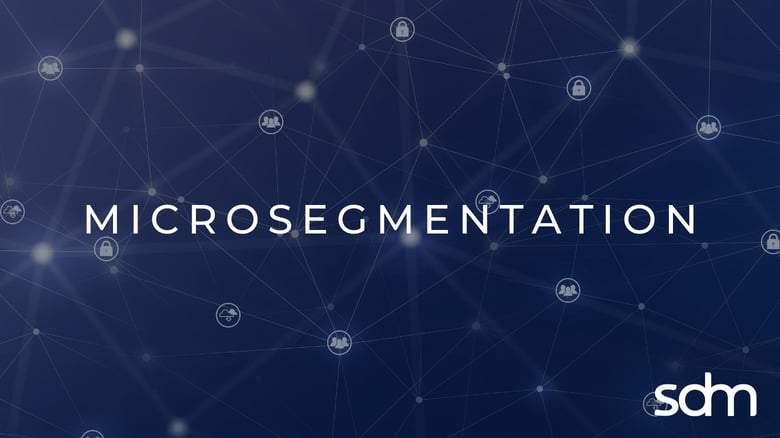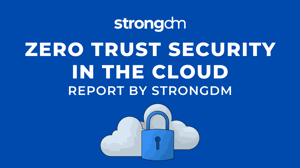A Beginner’s Guide to Microsegmentation


Written by
Schuyler BrownLast updated on:
June 25, 2025Reading time:
Contents
Built for Security. Loved by Devs.
- Free Trial — No Credit Card Needed
- Full Access to All Features
- Trusted by the Fortune 100, early startups, and everyone in between
Summary: In this article, we’ll review the basics of microsegmentation and discuss it in context with other network security models and practices, including Zero Trust, software-defined networking, and network segmentation. You’ll learn about the benefits of microsegmentation, how it works, challenges for implementation, and best practices.
What Is Microsegmentation?
Microsegmentation is a network security practice that creates secure zones within data center environments by segmenting application workloads into intelligent groupings and securing them individually.
It sets the foundation for a Zero Trust network security trust model, in which only explicitly authorized traffic can move across software-defined network perimeters to safeguard critical applications from unsanctioned activity.
Microsegmentation allows security teams to provide gap-free protection with granular visibility for greater control and precision across cloud environments and physical infrastructure. This enables stronger security controls across the network by reducing the network attack surface, strengthening breach containment, and improving regulatory compliance posture.
Zero Trust and microsegmentation
Zero Trust operates under the assumption that no user, endpoint, application, or workload can be trusted without verification. But in a constantly changing environment, applying Zero Trust can be a complex task.
Microsegmentation enables organizations to apply Zero Trust initiatives in a dynamic environment. It allows security teams to isolate network segments and then control who and what has access across those segments with precision. This means that no unauthorized users can travel laterally by piggybacking on approved policies, limiting the attack surface while better protecting sensitive data.
Software-defined networking and microsegmentation
Software-defined networking (SDN) is a network architecture approach that virtualizes network functionality for a software-based centralized control of network traffic. Traditional network models use dedicated hardware devices like routers to control traffic. SDN is a more flexible option that allows network architects to create and manage either a virtual network or traditional hardware through a software application.
Microsegmentation enables a software-only approach to security in SDNs. Rather than applying traditional perimeter security and hardware-based firewalls, it allows applications to run in their own secured segments behind a virtualized network environment layered over the physical network.
Isolating workloads over a completely virtualized network means that applications are not impacted by physical network restructuring or reconfiguration. This ensures consistent security policy across the network and sets your IT team up for a seamless transition if you scale or move workloads. While microsegmentation can be implemented with traditional physical networks, SDN-enabled microsegmentation delivers flexible, secure, on-demand services that improve operations while reducing IT overhead.
5 Benefits of Microsegmentation
1. Reduced network attack surface
Microsegmentation reduces the potential attack surface for a data breach by limiting the ability of attackers to move laterally through a network—even if they break through the outer security perimeter. A microsegmentation Zero Trust model allows teams to isolate workloads so that all east-west traffic flowing between devices in the datacenter is verified and authorized. Segmenting the network on a more granular level enables administrators to implement more precise verification controls across the network so that no traffic moves without authorization.
If a breach does occur, microsegmentation products, such as those offered by StrongDM, can trigger real-time alerts to security policy violations that enable IT teams to address issues quickly before more damage can be done. Cybersecurity Ventures estimates that cybercrime costs will grow 15% per year over the next five years; reducing your attack surface is a key strategy for strengthening network security and protecting your most important data assets.
2. Stronger defense against Advanced Persistent Threats
Advanced Persistent Threats (APTs) are security incidents that occur over a long period of time as an attacker attempts to move undetected through the network to gain increased access. By the time an organization identifies the original breach in a traditional network, the attacker has often already moved on to other parts of the network.
A network microsegmentation security approach helps limit malicious activity to the initial workload that was breached by isolating those segments from other parts of the network and making it more difficult for attackers to gain access—containing the threat from further spread.
3. Improved compliance
A traditional network that has not been segmented must apply complicated security policies across the entire network to meet regulatory compliance standards. Microsegmentation limits the scope and complexity of what is needed to meet network compliance requirements by preventing lateral movement—making it possible to segment sensitive data from the rest of the network and configure strict security standards for those segments. This saves time, money, and resources while improving the entire network security posture.
4. Simplified security
Microsegmentation provides greater control of network security with flexible, dynamic policies based on user needs and workload functions. Instead of creating complicated, coarse policies implemented across the network, security configurations can be tailored to each workload so that the appropriate level of security remains with the applications as the latter are moved and scaled. This simplifies security configurations and streamlines operations, while freeing up your IT team to focus on other business priorities.
5. Greater visibility in hybrid cloud environments
In traditional perimeter-based network segmentation security models, traffic is monitored as it travels in and out of the network. Once it is inside the perimeter, the traffic is considered “trusted” and can more easily move around the network environment without detection—creating vulnerable blind spots within the network.
Microsegmentation reduces these network security blind spots by controlling threat vectors at the workload and process level. Any attempted or blocked connection will trigger a security alert that notifies system administrators of a possible breach within that specific area. As a result, security teams get increased visibility into their hybrid environments with pinpoint precision, enabling effective monitoring and quick response time to threats.
Network Segmentation vs. Microsegmentation: What's the Difference?
Both network segmentation and microsegmentation help IT organizations improve network security and performance. Combining both of these strategies with a Zero Trust model is the best possible plan for security management across networks.
Network segmentation vs. Microsegmentation
Network segmentation is the practice of segmenting or isolating a network into smaller sub-networks to prevent movement from attackers across networks. From a security perspective, traditional network segmentation focuses on north-south traffic in and out of the network. The biggest drawback to this approach is that once a user is inside the network perimeter, they are generally trusted within that network segment. That’s why network segmentation is best used in conjunction with a Zero Trust microsegmentation strategy.
Microsegmentation addresses the aforementioned security vulnerability by focusing on east-west traffic. Microsegmentation goes a step further than network segmentation to divide the data center into security segments based on individual workload levels. These segments are monitored with a Zero Trust strategy to manage lateral movement, giving IT greater control to manage their security policies based on each unique segment. This offers a much more dynamic and flexible solution to network security for modern IT environments.
| Network segmentation | Microsegmentation |
|---|---|
| Vertical, north-south communication | Horizontal, east-west communication |
| Physical network | Virtual or overlay network via SDNs |
| Coarse policy controls | Granular policy controls |
| Network-level security | Workload-level security |
| Policies enforced on VLANs and subnets | Policies enforced on virtual machines |
Microsegmentation Security Challenges
Microsegmentation is a big initiative, which introduces its own implementation challenges. Here are two key challenges organizations must overcome when applying a microsegmentation strategy.
Requires high-visibility into architecture topology
Dividing a network into isolated security zones and controlling traffic between them is not for the faint of heart. Implementing a strong microsegmentation strategy requires an administrator who has a fundamental understanding of your network security environment.
Legacy architectures usually undergo piecemeal evolution over years and comprehensive architecture documentation is often scarce, making visibility a challenge. Administrators who jump in and try to apply microsegmentation to existing architectures without first getting the lay of the land often create security gaps and blind spots. Without a clear map of your environment, your microsegmentation efforts are guesswork and leave the network vulnerable.
Policy discovery and knowledge of application behavior
One of the key benefits of microsegmentation is the ability to apply unique security policies to network segments as needed. To identify which policies need to be applied to specific assets within your network, you need to know what’s communicating, how it’s communicating, when it’s communicating, and why.
Easier said than done.
Uncovering and managing the policy lifecycle is a complex effort that takes time and ongoing observation. Traditional approaches involve tagging every endpoint manually and capturing network behavior, but this isn’t sufficient (or effective) for dynamic workloads that scale up and down. The data is often stale as soon as it’s collected, always leaving your team one step behind. Instead, IT teams need to take a phased approach that builds on previous segmentation policies over time and takes advantage of automated processes along the way.
Microsegmentation Best Practices
The right strategies and implementation practices are crucial for an effective microsegmentation initiative. Set your organization up for success with these best practices:
1. Map your network architecture
Effective microsegmentation requires a comprehensive understanding of your network architecture so you can accurately identify, configure, and enforce security policies that work. Before you start planning microsegmentation, take inventory of your current infrastructure and document your network architecture. This will provide the blueprint from which you can begin investigating traffic behavior and approach policy discovery.
2. Observe traffic behavior and communication patterns
As part of mapping your architecture, observe your current state to uncover communication patterns and regular traffic behavior. To write secure policies that protect and enforce east-west traffic, you have to know where traffic is flowing and where communication is occurring. Guessing these behaviors will inevitably lead to blind spots and gaps in security.
3. Take a phased approach
Finally, don’t rush microsegmentation. This is not a sprint or a one-and-done implementation. For best results, take a phased approach that tackles segmentation in stages: start with broad, zone-based network segmentation policies, then narrow to application-based policies, and gradually work towards more granular (micro) policies. This will make implementation more manageable and enhance your security.
More Security, Less Hassle
One of the biggest drawbacks to implementing microsegmentation is the scale and complexity of the task. But with the right microsegmentation tools, strategies, and support in place, you can modernize your network and strengthen your security posture.
StrongDM gives IT organizations the resources they need to better manage their cloud assets by applying Zero Trust microsegmentation policies that limit lateral movement and contain breaches at their source.
Next Steps
StrongDM unifies access management across databases, servers, clusters, and more—for IT, security, and DevOps teams.
- Learn how StrongDM works
- Book a personalized demo
- Start your free StrongDM trial

Categories:

About the Author
Schuyler Brown, Chairman of the Board, began working with startups as one of the first employees at Cross Commerce Media. Since then, he has worked at the venture capital firms DFJ Gotham and High Peaks Venture Partners. He is also the host of Founders@Fail and author of Inc.com's "Failing Forward" column, where he interviews veteran entrepreneurs about the bumps, bruises, and reality of life in the startup trenches. His leadership philosophy: be humble enough to realize you don’t know everything and curious enough to want to learn more. He holds a B.A. and M.B.A. from Columbia University. To contact Schuyler, visit him on LinkedIn.
You May Also Like




